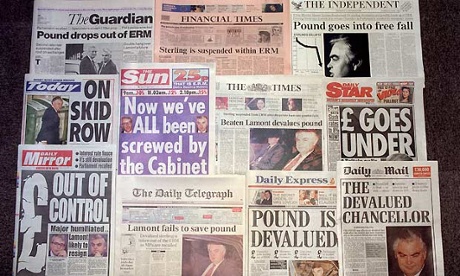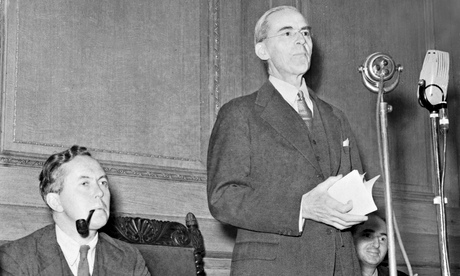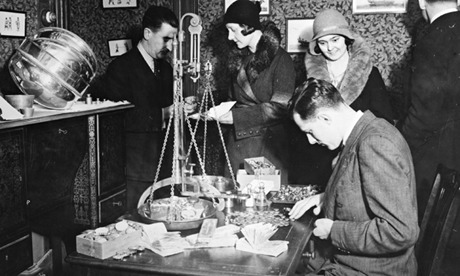Sterling's worst moments in the past 100 years have generally come in this month, so Scotland's vote could not be worse timed

Black Wednesday - 16 September 1992. How newspapers reported the sterling crisis. Photograph: Harris/PA Archive/Press Association Ima
April is the cruellest month, TS Eliot once wrote. Not for the pound, it isn't. Without question the month that holds the maximum danger for sterling is September. What's more, this week – the week in which Scotland decides whether it wants to become an independent country – tends to be the scariest week of the scariest month.
Consider the evidence. There were five big sterling crises in the 20th century, and four of them came to the boil in September. In the circumstances, it's not hard to see why foreign exchange dealers will be at their desks early on Friday morning to await news from Edinburgh about the referendum vote.
The story starts in 1931, two years after the Wall Street Crash and six years after Sir Winston Churchill had, with some misgivings, put Britain back on the Gold Standard at its pre first world war rate. This involved a revaluation of the pound, a move that made UK exports more expensive. Industry's pain intensified when global trade started to contract in the early years of the Great Depression.
The Labour government of James Ramsay Macdonald found that it could only balance the budget by imposing spending cuts that led to a split in the party and the formation of a coalition. International investors were spooked by a mutiny of sailors at Invergordon and capital flight was not staunched by an austerity budget. Sterling left the Gold Standard forever on 21 September 1931.
Roll forward 18 years and Labour is back in power, this time led by Clement Attlee. An ailing Sir Stafford Cripps is chancellor of the exchequer and the British economy has been hit hard by the cost of six years of total war, and is struggling to meet the twin commitments of high military spending and the welfare state.

Sir Stafford Cripps, former chancellor of the exchequer, discussing aspects of the devaluation of the pound. Photograph: Planet News Archive/SSPL via Getty Images
With the German, French, Italian and Japanese economies all in much worse shape than Britain's, the Attlee administration sees an opportunity to rebuild the economy through an export drive. This though is hampered by the level of the pound, pegged at too high a level against the dollar. Eventually, with Britain's gold and foreign currency reserves dwindling, Cripps agrees to a 30% devaluation. The date: 19 September 1949.
In 1949, Denis Healey was a would-be Labour MP, yet to enter parliament. Twenty-seven years later he was at the centre of the next big September meltdown for sterling, one that eventually resulted in Jim Callaghan's government seeking financial help from the International Monetary Fund.
Just as George Osborne was due to attend a meeting of G20 finance ministers this week, so Healey was due to be out of the country in late September 1976. Unlike Osborne, who scrapped his planned trip a week in advance, Healey was on his way to Heathrow for a flight to Manila, where the annual meeting of the IMF was being held, when he got the news that the pound was coming under intense pressure on the foreign exchanges. The chancellor decided to abort his trip and instead travelled up to Blackpool to attend Labour's annual conference. On the last day of September, Healey urged a sceptical party to get behind the government. The humiliating terms of the IMF loan were announced just before Christmas.

A man weighing gold after the lifting of the Gold Standard in 1931 encouraged people to sell. Photograph: Hulton Archive/Getty Images
The last major trauma was in the 1990s, 16 September 1992 to be exact. This was the date when John Major's government abandoned attempts to keep the pound in the European exchange rate mechanism. It was the date the Bank of England took on the currency speculators led by George Soros and lost. It was the date when the Treasury, then responsible for setting interest rates, announced two increases in the cost of borrowing.
That morning the chancellor, Norman Lamont, pushed official rates up from 10% to 12%. When that failed to ease pressure on the pound, he said the afternoon that rates would be raised to 15% the next morning. The second increase never occurred because by that time, sterling was out of the ERM.
Although there have been no sterling crises since the turn of the millennium, September has continued to be the month when bad stuff happens. September 2007 saw queues outside branches of Northern Rock, the first run on a major high street bank in the UK since the 1860s. A year later, on 15 September 2008, Lehman Brothers went bankrupt, leading within a month to the near-collapse of the western financial system.
That, of course, was in October 2008. But the moral of the story is that even when things don't go pear-shaped in September, there's a good chance of them doing so – 1929, 1987, 2008 – in October. History is just one of the reasons the Bank of England and the Treasury will be ready for action come Friday morning.
No comments:
Post a Comment